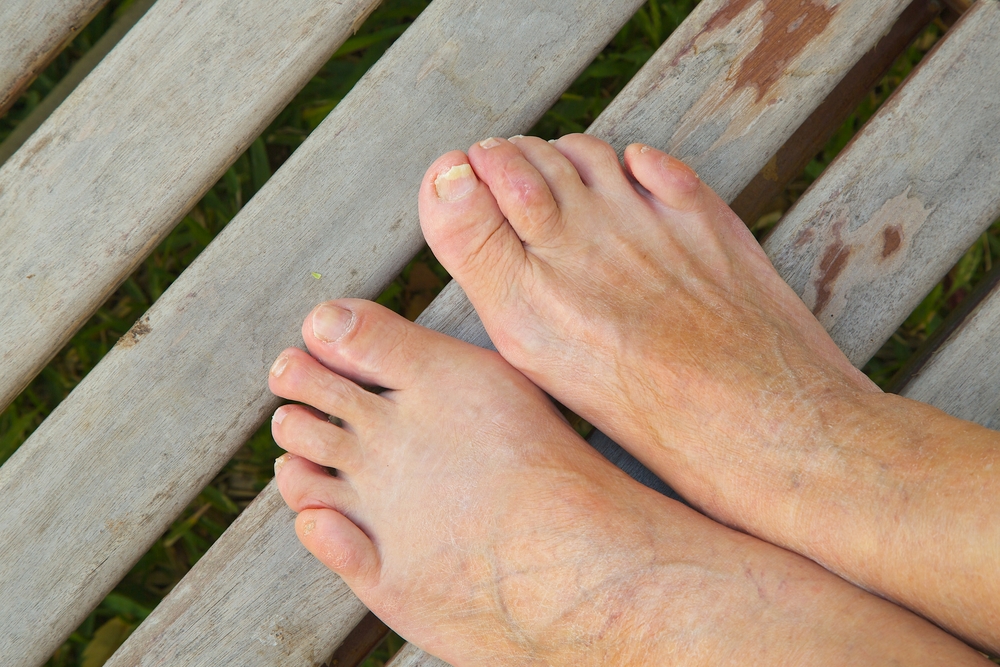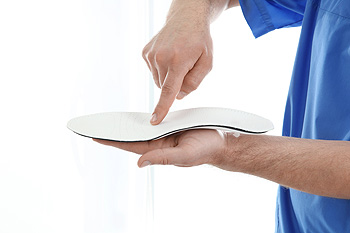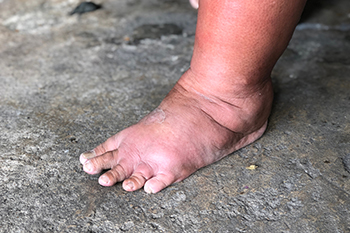Blog
Items filtered by date: November 2022
Hammertoe and Shoes

A hammertoe is a significantly unsightly affliction of the foot that can develop when the joint of a toe points upward at the middle of a toe. The toe can end up looking like a kind of hammer, which is why the condition is called hammertoe. One important thing to note about the condition of hammertoe is that it can be especially influenced by the kind of shoes that someone wears. For example, when someone wears high-heeled shoes, their toes can become pressed up against the tip of the shoe, essentially squishing the toes in the toe box. This does not bode well for the development of hammertoe. Also, other kinds of shoes simply do not fit correctly, perhaps because they are too tight and can ultimately squish the toes in the toe box. In this way, tight shoes and high heeled shoes might lead to conditions like hammertoe. Reach out to a podiatrist today for more information.
Hammertoe
Hammertoes can be a painful condition to live with. For more information, contact one of our doctors from Kitsap Foot & Ankle Clinic. Our doctors will answer any of your foot- and ankle-related questions.
Hammertoe is a foot deformity that affects the joints of the second, third, fourth, or fifth toes of your feet. It is a painful foot condition in which these toes curl and arch up, which can often lead to pain when wearing footwear.
Symptoms
- Pain in the affected toes
- Development of corns or calluses due to friction
- Inflammation
- Redness
- Contracture of the toes
Causes
Genetics – People who are genetically predisposed to hammertoe are often more susceptible
Arthritis – Because arthritis affects the joints in your toes, further deformities stemming from arthritis can occur
Trauma – Direct trauma to the toes could potentially lead to hammertoe
Ill-fitting shoes – Undue pressure on the front of the toes from ill-fitting shoes can potentially lead to the development of hammertoe
Treatment
Orthotics – Custom made inserts can be used to help relieve pressure placed on the toes and therefore relieve some of the pain associated with it
Medications – Oral medications such as anti-inflammatories or NSAIDs could be used to treat the pain and inflammation hammertoes causes. Injections of corticosteroids are also sometimes used
Surgery – In more severe cases where the hammertoes have become more rigid, foot surgery is a potential option
If you have any questions please contact one of our offices located in Bremerton and Port Orchard, WA . We offer the newest diagnostic and treatment technologies for all your foot and ankle needs.
Types of Orthotics for Different Foot Conditions

Orthotics may help correct specific types of abnormal foot structures. They have been used to find relief with hammertoes and bunions, and are made of different materials for specific foot conditions. Rigid orthotics may be successful in controlling the movement of the feet below the ankle joints, in addition to improving the range of motion. This type of orthotic may be used when the patient has arthritis, high arches, or plantar fasciitis. Existing diabetic foot wounds and foot deformities may be helped by wearing accommodative orthotics, and it may help to improve overall foot function. Semi-rigid orthotics are comprised of soft and rigid materials and are generally used to treat flat feet. Additionally, they have been used to treat children’s disorders such as in-toeing and out-toeing. If you have foot pain, it is strongly advised that you consult with a podiatrist who can determine which type of orthotic is correct for you, and measure your feet correctly for custom-made orthotics.
If you are having discomfort in your feet and would like to try orthotics, contact one of our doctors from Kitsap Foot & Ankle Clinic. Our doctors can provide the care you need to keep you pain-free and on your feet.
What Are Orthotics?
Orthotics are inserts you can place into your shoes to help with a variety of foot problems such as flat feet or foot pain. Orthotics provide relief and comfort for minor foot and heel pain but can’t correct serious biomechanical problems in your feet.
Over-the-Counter Inserts
Orthotics come in a wide variety of over-the-counter inserts that are used to treat foot pain, heel pain, and minor problems. For example, arch supports can be inserted into your shoes to help correct overarched or flat feet, while gel insoles are often used because they provide comfort and relief from foot and heel pain by alleviating pressure.
Prescription Orthotics
If over-the-counter inserts don’t work for you or if you have a more severe foot concern, it is possible to have your podiatrist prescribe custom orthotics. These high-quality inserts are designed to treat problems such as abnormal motion, plantar fasciitis, and severe forms of heel pain. They can even be used to help patients suffering from diabetes by treating foot ulcers and painful calluses and are usually molded to your feet individually, which allows them to provide full support and comfort.
If you are experiencing minor to severe foot or heel pain, it’s recommended to speak with your podiatrist about the possibilities of using orthotics. A podiatrist can determine which type of orthotic is right for you and allow you to take the first steps towards being pain-free.
If you have any questions please contact one of our offices located in Bremerton and Port Orchard, WA . We offer the newest diagnostic and treatment technologies for all your foot and ankle needs.
Arthritis Can Cause Pain in the Feet and Ankles
Risks of Charcot Foot in Diabetics

Charcot foot is a rare, but serious, complication of peripheral neuropathy brought on by diabetes. It affects the bones, joints, and soft tissues of the foot and ankle. Weakened joints can cause the bones to break and joints to dislocate. As a result, the shape of the foot changes. Charcot foot is deceptive and can be hard to diagnose, because symptoms include redness, hotness, and swelling. Because of that, it is often thought to be an infection. Although specific causes for Charcot foot are not clear, some conditions may help to indicate it. Often, because a diabetic with peripheral neuropathy cannot feel pain, a sprain or even a fracture can go unnoticed. In some cases, the foot becomes rounded on the bottom because the arch has collapsed. This also may indicate Charcot foot. Treatment varies from staying off the affected foot to surgery. People with Charcot foot may need to wear protective footwear, such as a cast, on a regular basis. If you suffer from diabetes and have developed peripheral neuropathy, it is highly recommended that you consult a podiatrist on a regular basis to monitor any unnoticed injuries that may indicate Charcot foot.
Diabetic foot care is important in preventing foot ailments such as ulcers. If you are suffering from diabetes or have any other concerns about your feet, contact one of our doctors from Kitsap Foot & Ankle Clinic. Our doctors can provide the care you need to keep you pain-free and on your feet.
Diabetic Foot Care
Diabetes affects millions of people every year. The condition can damage blood vessels in many parts of the body, especially the feet. Because of this, taking care of your feet is essential if you have diabetes, and having a podiatrist help monitor your foot health is highly recommended.
The Importance of Caring for Your Feet
- Routinely inspect your feet for bruises or sores.
- Wear socks that fit your feet comfortably.
- Wear comfortable shoes that provide adequate support.
Patients with diabetes should have their doctor monitor their blood levels, as blood sugar levels play such a huge role in diabetic care. Monitoring these levels on a regular basis is highly advised.
It is always best to inform your healthcare professional of any concerns you may have regarding your feet, especially for diabetic patients. Early treatment and routine foot examinations are keys to maintaining proper health, especially because severe complications can arise if proper treatment is not applied.
If you have any questions please feel free to contact one of our offices located in Bremerton and Port Orchard, WA . We offer the newest diagnostic and treatment technologies for all your foot and ankle needs.
All About Flexible Flat Feet

Flexible flat feet often begin to develop in childhood and adolescence and continue through adulthood. As the condition progresses, the tendons and ligaments of the foot may stretch, tear, or become inflamed. You probably have flexible flat feet when your foot is flat to the ground while standing, but the arch reappears when the weight is taken off it. Symptoms of flexible flat feet include pain in the heel, arch, ankle, and side of the foot. Another sign is overpronation, where the ankle rolls inward. These symptoms can cause further pain and fatigue in the legs, knees, hips, and back. Losing weight is one way to reduce the effects of having flexible flat feet. Wearing shoes with adequate arch support can also be helpful. One of the main ways to treat flexible flat feet is by wearing orthotic devices in your shoes. A podiatrist can prescribe and produce custom orthotics after a complete examination of your specific condition. In severe cases, an advanced bracing device may be recommended. In a few cases, surgery may be considered, based on age, level of activity, and diagnostic tests. If you have questions about flexible flat feet, it is wise to consult a podiatrist.
Flatfoot is a condition many people suffer from. If you have flat feet, contact one of our doctors from Kitsap Foot & Ankle Clinic. Our doctors will treat your foot and ankle needs.
What Are Flat Feet?
Flatfoot is a condition in which the arch of the foot is depressed and the sole of the foot is almost completely in contact with the ground. About 20-30% of the population generally has flat feet because their arches never formed during growth.
Conditions & Problems:
Having flat feet makes it difficult to run or walk because of the stress placed on the ankles.
Alignment – The general alignment of your legs can be disrupted, because the ankles move inward which can cause major discomfort.
Knees – If you have complications with your knees, flat feet can be a contributor to arthritis in that area.
Symptoms
- Pain around the heel or arch area
- Trouble standing on the tip toe
- Swelling around the inside of the ankle
- Flat look to one or both feet
- Having your shoes feel uneven when worn
Treatment
If you are experiencing pain and stress on the foot you may weaken the posterior tibial tendon, which runs around the inside of the ankle.
If you have any questions please feel free to contact one of our offices located in Bremerton and Port Orchard, WA . We offer the newest diagnostic and treatment technologies for all your foot and ankle needs.
Swollen Feet From Tight Shoes

The swelling of the feet can be caused by several different things. One often overlooked cause of swollen feet is wearing shoes that do not fit correctly and are too tight. The reason that a tight pair of shoes can cause swelling is because the tightness can reduce circulation and discourage blood flow. Sometimes when an individual selects a pair of shoes that does not conform to their foot shape and size, the shoes can end up cutting off circulation. For example, an individual might have a particularly wide foot, and if they select a regular pair of shoes that is too narrow in shape, the shoes might be too tight. It might also be useful to know that an individual can prevent swelling from tight shoes by remembering not to buy small shoes at the store, thinking that they can be “broken in.” Typically, this is not advisable. Contact a podiatrist today for more information.
Swollen feet can be a sign of an underlying condition. If you have any concerns, contact one of our doctors of Kitsap Foot & Ankle Clinic. Our doctors can provide the care you need to keep you pain-free and on your feet.
Swollen feet are a common ailment among pregnant women and people who stand or sit for extended periods. Aging may increase the possibility of swollen feet and patients who are obese often notice when their feet are swelling too. There may be medical reasons why swollen feet occur:
- Phlebitis - A condition that causes the veins to become inflamed and can also cause leg pain.
- Liver disease - This may lead to low blood levels of albumin which is a protein. This can cause fluid in the blood to pass into the tissues and several areas of the body can become swollen.
- Heart failure - When the heart doesn’t pump properly the blood that is normally pumped back to the heart can pool in the veins of the legs causing swollen feet.
- Kidney disease - One of the main functions of the kidneys is releasing excess fluid in the body. This type of condition can make it difficult for the kidneys to function properly, and as a result the feet may become swollen.
- Deep-vein thrombosis (DVT)- This is a serious condition where blood clots form in the veins of the legs. They can block the return of blood from the legs to the heart which may cause the feet to swell. It is important to be treated by a podiatrist if this condition is present.
Swollen feet can also be caused by bone and tendon conditions, including fractures, arthritis, and tendinitis. Additionally, there may be skin and toenail conditions and an infection may cause the feet to swell. Patients who take medicine to treat high blood pressure may be prone to getting swollen feet.
Many patients elevate their feet to help relieve the swelling and this is generally a temporary remedy. When a podiatrist is consulted the reason behind the swelling can be uncovered and subsequently treated.
If you have any questions please feel free to contact one of our offices located in Bremerton and Port Orchard, WA . We offer the newest diagnostic tools and technology to treat your foot and ankle needs.

